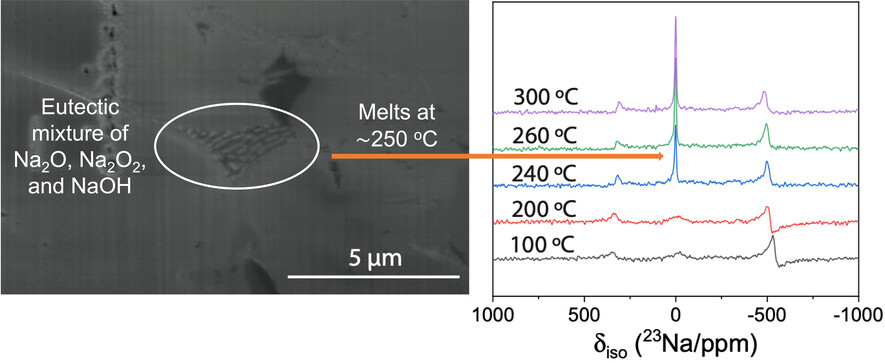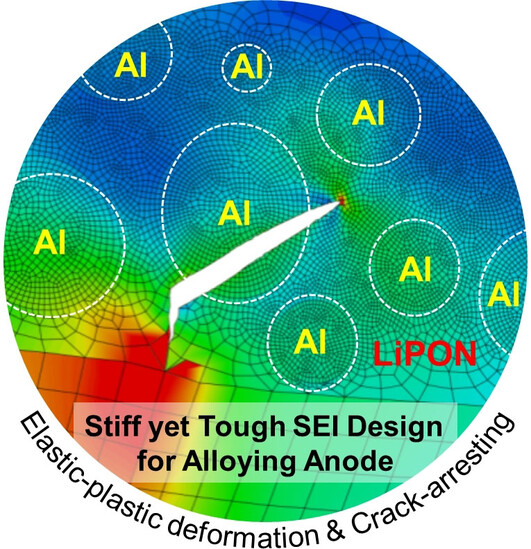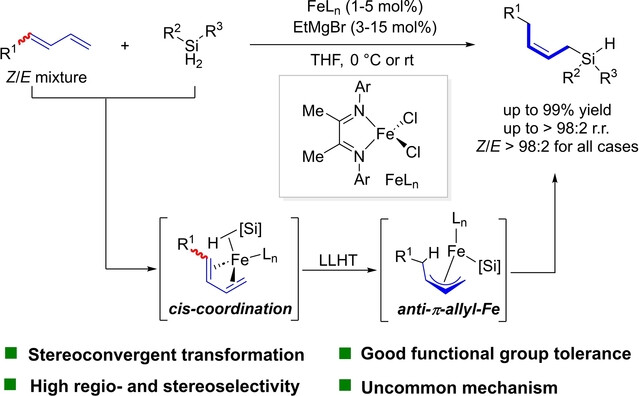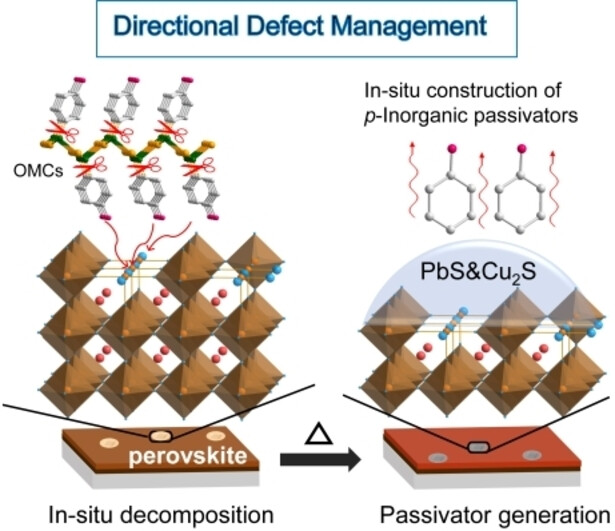Journal list menu
Export Citations
Download PDFs
Covers
Titelbild: Anchoring a Structurally Editable Proximal Cofactor-like Module to Construct an Artificial Dual-center Peroxygenase (Angew. Chem. 51/2023)
- First Published: 27 October 2023
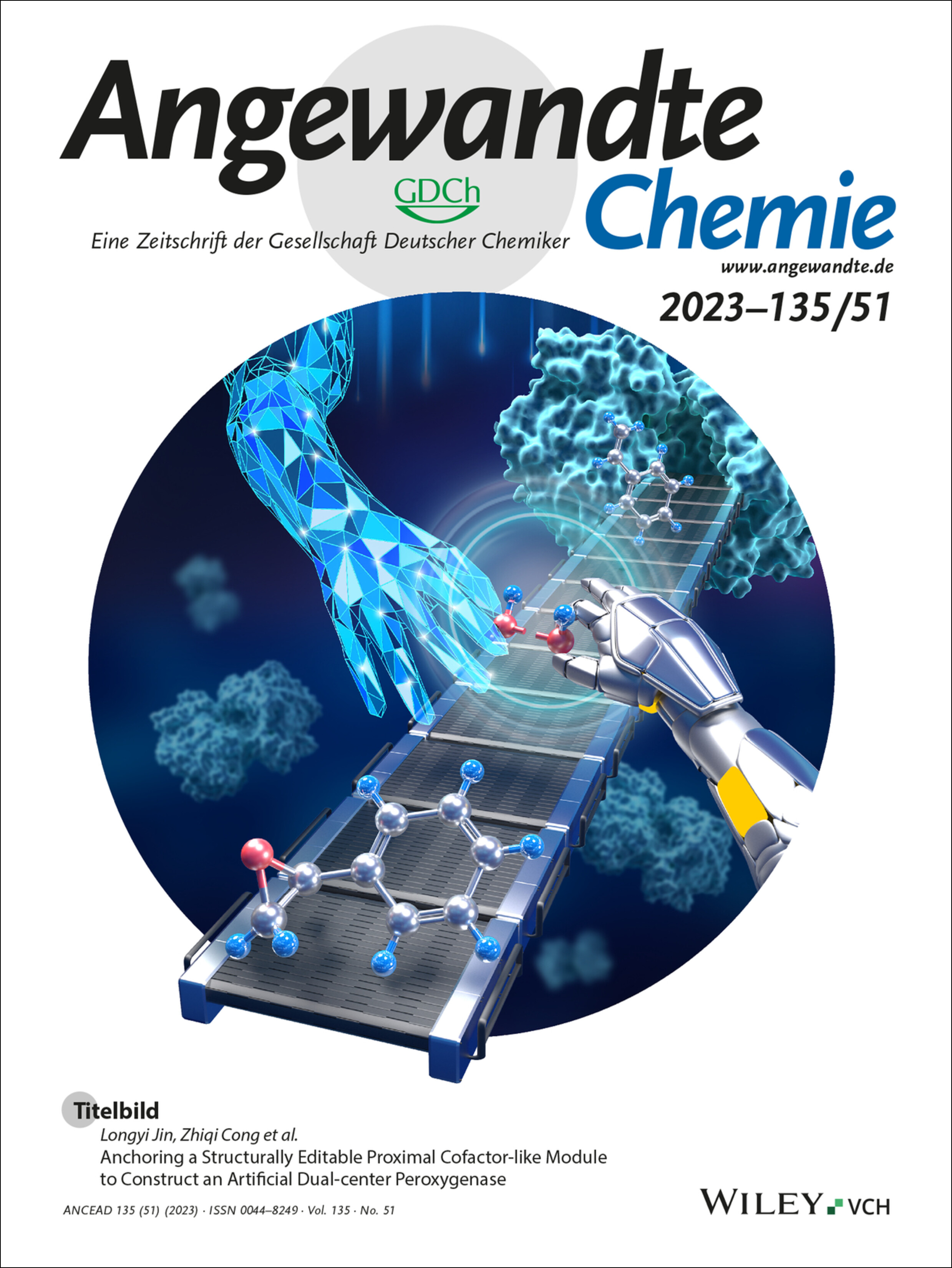
An artificial dual-center peroxygenase was constructed by anchoring an editable organic cofactor to the proximal position of the heme center of P450BM3 as a co-catalytic center. This provides an unprecedented approach for assembling artificial metalloenzymes and substantially increases the catalytic promiscuity of P450 enzymes, as described by Longyi Jin, Zhiqi Cong et al. in their Research Article (e202311259).
Innentitelbild: Dual Tunability for Uncatalyzed N-Alkylation of Primary Amines Enabled by Plasma-Microdroplet Fusion (Angew. Chem. 51/2023)
- First Published: 27 October 2023
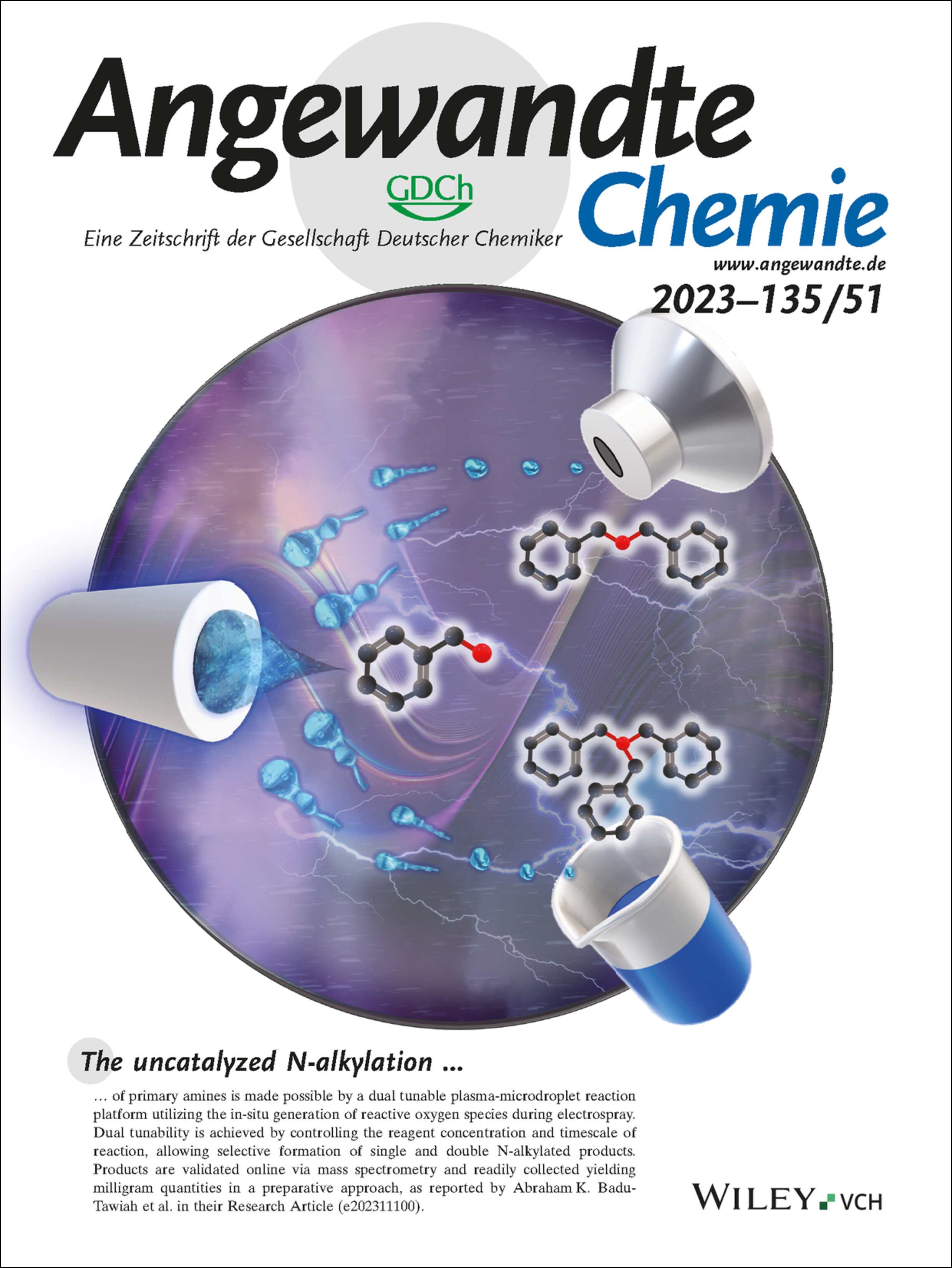
The uncatalyzed N-alkylation of primary amines is made possible by a dual tunable plasma-microdroplet reaction platform utilizing the in-situ generation of reactive oxygen species during electrospray. Dual tunability is achieved by controlling the reagent concentration and timescale of reaction, allowing selective formation of single and double N-alkylated products. Products are validated online via mass spectrometry and readily collected yielding milligram quantities in a preparative approach, as reported by Abraham K. Badu-Tawiah et al. in their Research Article (e202311100).
Innenrücktitelbild: Bioactive Luminescent Silver Clusters Confined in Zeolites Enable Quick and Wash-Free Biosensing (Angew. Chem. 51/2023)
- First Published: 10 November 2023
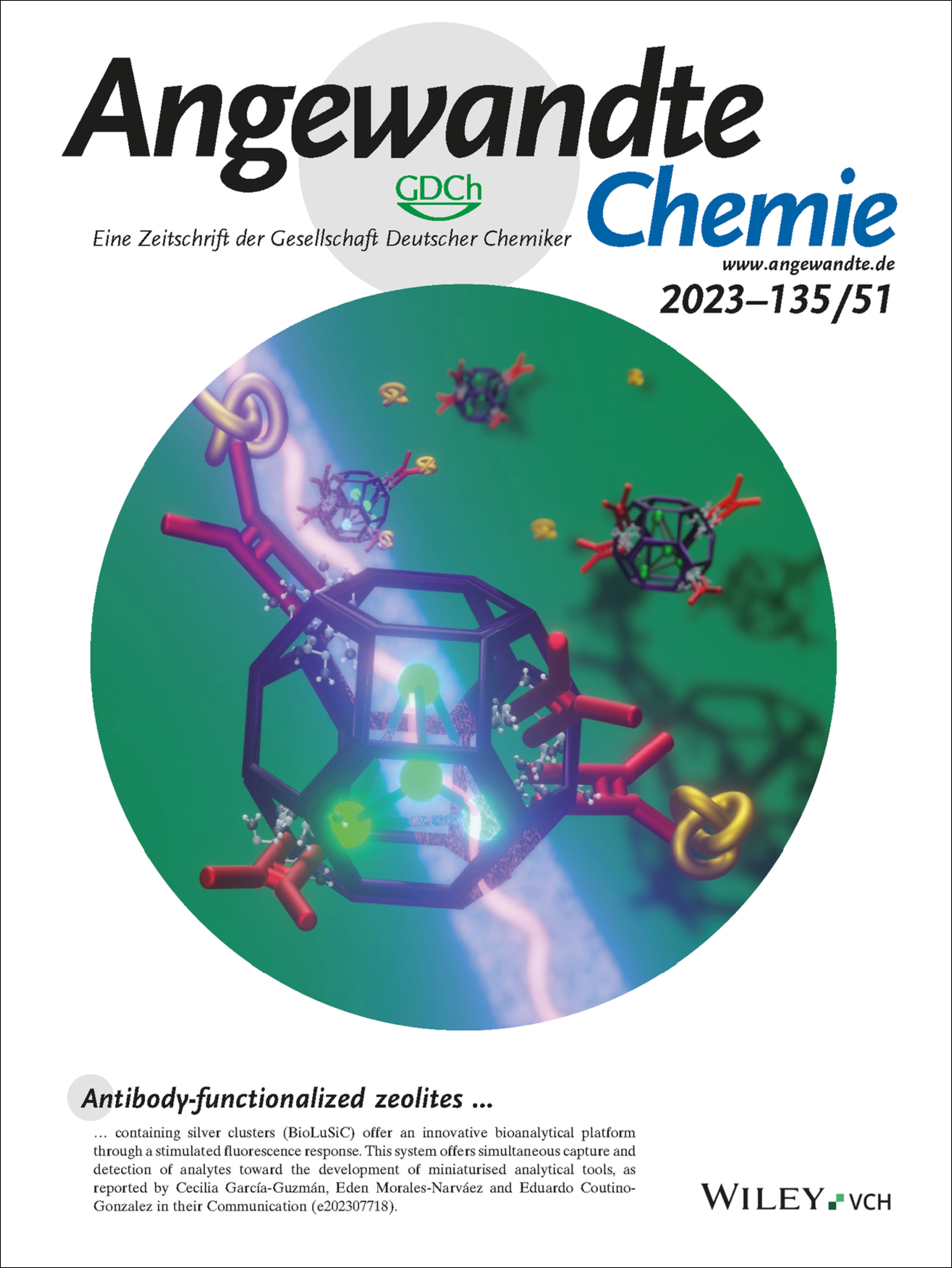
Antibody-functionalized zeolites containing silver clusters (BioLuSiC) offer an innovative bioanalytical platform through a stimulated fluorescence response. This system offers simultaneous capture and detection of analytes toward the development of miniaturised analytical tools, as reported by Cecilia García-Guzmán, Eden Morales-Narváez and Eduardo Coutino-Gonzalez in their Communication (e202307718).
Rücktitelbild: Locking the Conformation of a Paddlewheel Rhodium Complex: Design, Synthesis, and Applications in Catalytic Nitrene Transfers (Angew. Chem. 51/2023)
- First Published: 10 November 2023
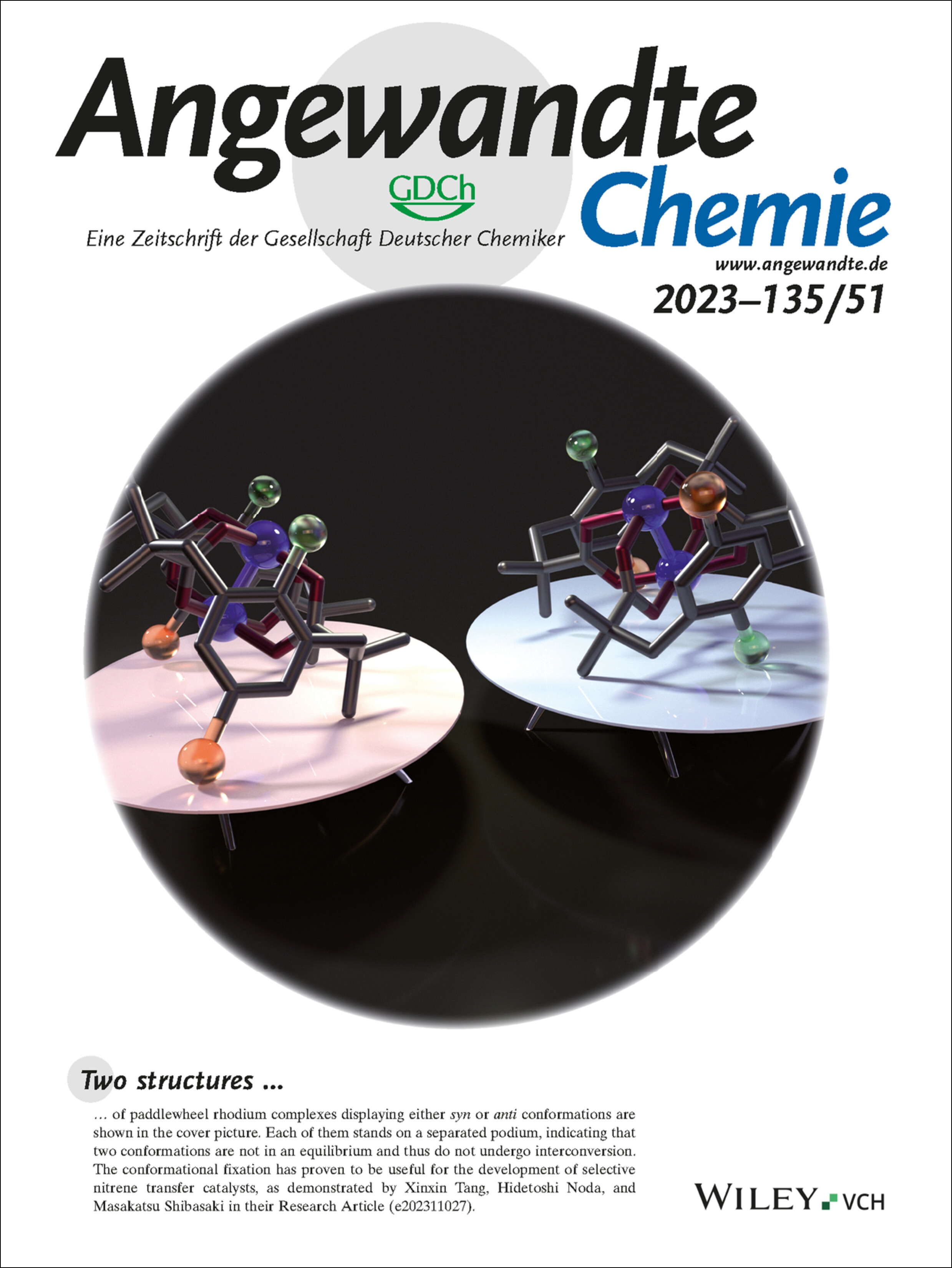
Two structures of paddlewheel rhodium complexes displaying either syn or anti conformations are shown in the cover picture. Each of them stands on a separated podium, indicating that two conformations are not in an equilibrium and thus do not undergo interconversion. The conformational fixation has proven to be useful for the development of selective nitrene transfer catalysts, as demonstrated by Xinxin Tang, Hidetoshi Noda, and Masakatsu Shibasaki in their Research Article (e202311027).
Frontispiz
Frontispiz: Von Benzoborirenen zu Benzoborol-basierenden 1,2-Diiminen und antiaromatischen Boroldiiden
- First Published: 11 December 2023
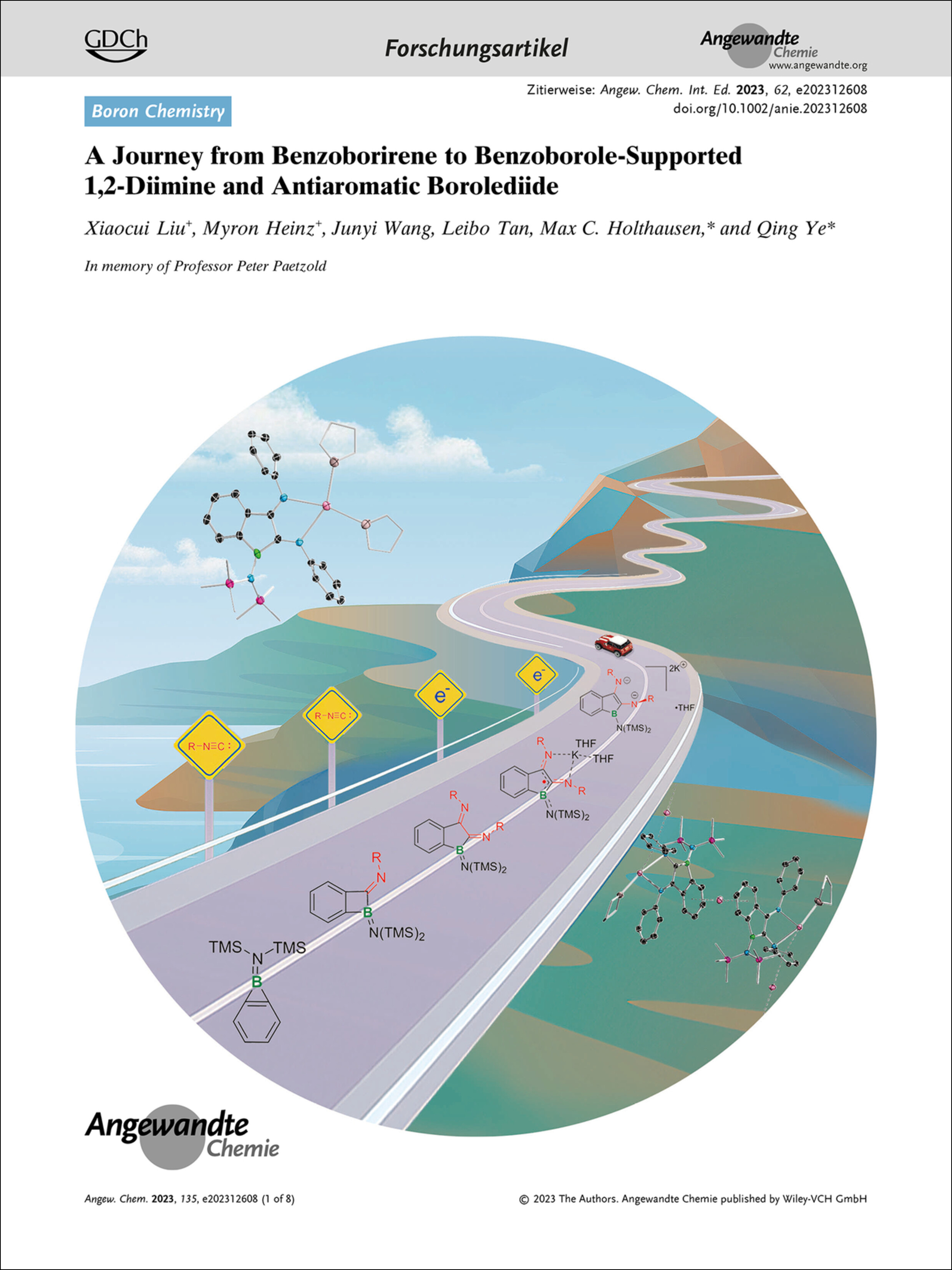
Boron Compounds. The synthesis of 2,3-dihydro-2,3-diiminoboroles through regioselective double insertion of isocyanide into benzoborirenes is reported by Max C. Holthausen, Qing Ye et al. in their Communcation (e202312608).
Graphisches Inhaltsverzeichnis
Graphisches Inhaltsverzeichnis: Angew. Chem. 51/2023
- First Published: 11 December 2023
Announcement
Classifieds: Jobs and Awards, Products and Services
- First Published: 11 December 2023
Team Profile
Elucidation of Organometallic Reaction Mechanisms by a China–Germany Team
- First Published: 30 October 2023
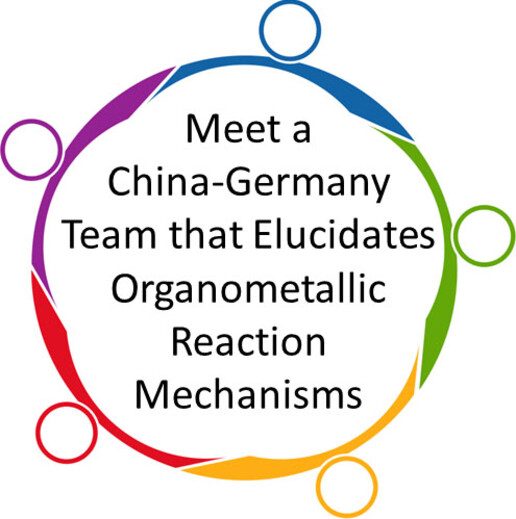
“It was wonderful to see how theory and experiment went hand in hand and complemented each other from an early stage of the project… Dominik and Jiaxiang were happy to see during this joint project that the teamwork from their postdoc days continues to pay out not only on a personal level, but also scientifically in the long run…„ Find out more about the collaborative work in the Chu and Munz groups.
Introducing …
Highlights
Plastic Recycling
Converting Waste Plastic to Liquid Organic Hydrogen Carriers
- First Published: 20 November 2023

The recent findings from J. Wei et al. where they developed a catalytic system to convert mixed oxygenated aromatic plastic waste into liquid organic hydrogen carriers are highlighted herein. The catalytic system comprises a physical mixture of Ru−ReOx supported on SiO2 and zeolite HZSM-5, which work together to break apart C−O bonds in the polymers to form cycloalkanes via hydrodeoxygenation.
Kurzaufsätze
Liquid Crystals
Liquid Crystal Emulsions: A Versatile Platform for Photonics, Sensing, and Active Matter
- First Published: 11 September 2023
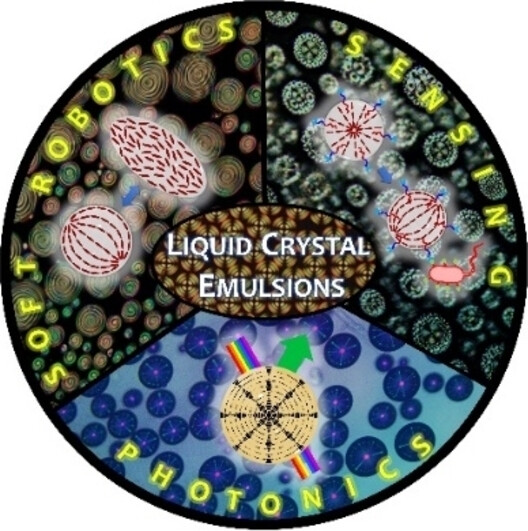
Liquid crystal emulsions have recently opened new opportunities for the design of soft responsive materials. These recent findings have enabled a wealth of unprecedented applications in photonics (e.g. retroreflectors, lasing materials), sensing (e.g. detection of biomolecules, pathogens), soft robotics (e.g. micropumps, artificial muscles), and beyond.
Analytical Methods
Point-of-Care Testing for the Detection of MicroRNAs: Towards Liquid Biopsy on a Chip
- First Published: 06 September 2023
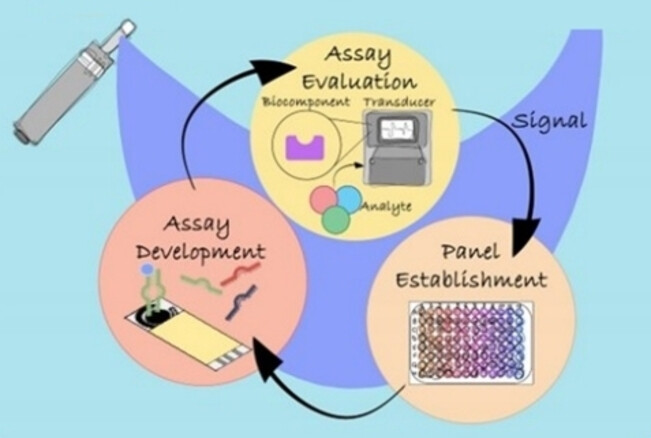
Implementation of point of care (PoC) devices for miRNA detection in clinical oncology is urgently needed. Here, the main field of applications and the most promising biosensing platforms for sensitive miRNA detection are discussed. The need to establish multidisciplinary networks to boost biosensing technologies and bring them to the clinic to develop and spread PoC is also highlighted. The outlook is to improve the access to molecular diagnostics tools to all patients.
Supramolecular Chemistry
Exploiting Chirality in Confined Nanospaces
- First Published: 04 September 2023
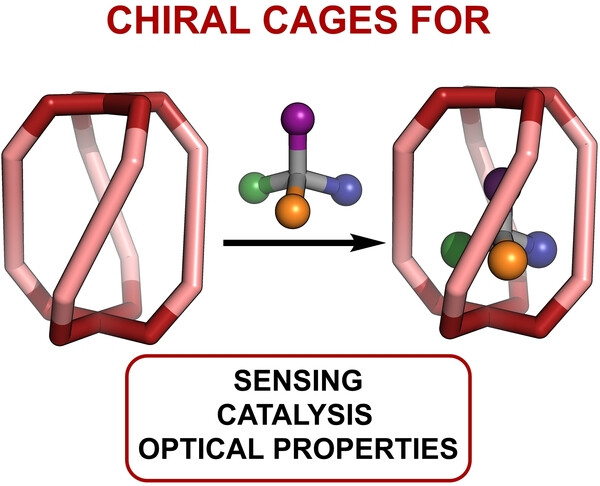
The development of novel synthetic strategies for the preparation of chiral supramolecular cages has led in the recent years to a boost in their applications. This minireview highlights some recent examples of the applications that these systems have found in catalysis, sensing and in the development of systems with novel chiral optical activities.
Aufsätze
Metal Batteries
A Deeper Understanding of Metal Nucleation and Growth in Rechargeable Metal Batteries Through Theory and Experiment
- First Published: 21 September 2023

Rechargeable metal batteries are still at the forefront of battery research. Each battery cell component that relates to anode performance (the current collector, anode surface, solid-electrolyte interphase (SEI), and electrolyte) is described by a unique set of applicable models and theories to better understand and predict metal nucleation and growth.
Elektrokatalyse
Auf dem Weg zum Verständnis des Bildungs- und OER-Katalysemechanismus von Hydroxiden durch In situ- und Operando-Techniken
- First Published: 31 August 2023

Diskussionen über den aktuellen Stand und die Herausforderungen bei der Untersuchung der Bildung von Hydroxiden und der OER-Katalysemechanismen mittels In situ/Operando-Techniken können dazu beitragen, die Herstellung kostengünstiger Hydroxidelektrokatalysatoren zu beschleunigen. Dieses Review fasst die Möglichkeiten, Vor- und Nachteile der In situ/Operando-Techniken zusammen und erörtert die jüngsten Erkenntnisse über die Bildung von Hydroxiden und den OER-Katalysemechanismus. Außerdem werden aktuelle Herausforderungen aufgezeigt und Lösungsstrategien vorgeschlagen.
Forschungsartikel
Borchemie
Von Benzoborirenen zu Benzoborol-basierenden 1,2-Diiminen und antiaromatischen Boroldiiden
- First Published: 27 September 2023

Die regioselektive doppelte Insertion von Isocyaniden in ein Benzoboriren führt zu 2,3-Dihydro-2,3-diiminoborolen, die eine neue Art von redoxaktiven 1,2-Diiminen mit einem Benzoborol-Grundgerüst darstellen. Die einfach und doppelt reduzierten Spezies wurden vollständig charakterisiert, wobei die Antiaromatizität des Boroldiids nachgewiesen wurde. Detaillierte quantenchemische Berechnungen liefern eine Erklärung für die beobachtete Regioselektivität.
CO2-Hydrierung
Niedrige Temperatur Hydrierung von CO2 zu Methanol in Wasser auf ZnO-geträgerten CuAu-Nanolegierungen
- First Published: 19 October 2023
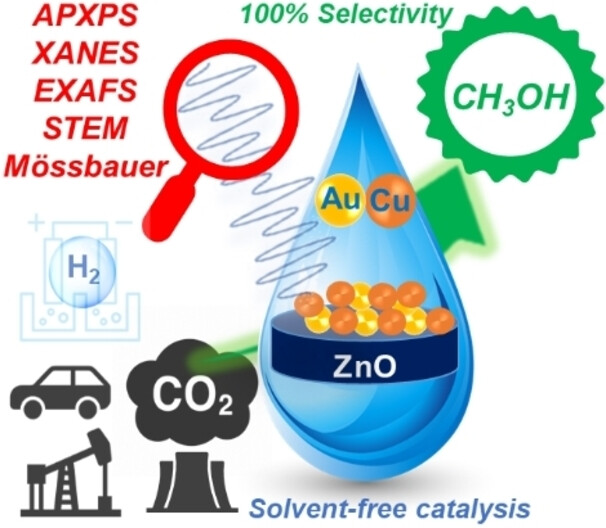
Die CO2-Hydrierung unter Verwendung von grünem Wasserstoff ist derzeit ein gut etabliertes Ziel zur Kontrolle der globalen Erwärmung und zur nachhaltigen Nutzung erneuerbarer Energien. Wir zeigen, dass CO2 in flüssigem Wasser auf ZnO-gestützten CuAu-Nanolegierungen selektiv zu Methanol reduziert werden kann. Die Struktur und die elektronischen Eigenschaften wurden mit Hilfe von Elektronenmikroskopie, 197Au-Mössbauer-, Röntgenabsorptions- und Röntgenphotoelektronenspektroskopie bei Umgebungsdruck aufgeklärt.
Lewis-Säuren
Aluminium(III)-Kationen [(NHC) ⋅ AlMes2]+: Synthese, Charakterisierung und Anwendung in der FLP-Chemie
- First Published: 25 October 2023
![Aluminium(III)-Kationen [(NHC) ⋅ AlMes2]+: Synthese, Charakterisierung und Anwendung in der FLP-Chemie](/cms/asset/edb9d150-e8a3-4a37-b1ac-d06f1f3cc67d/ange202312111-toc-0001-m.jpg)
Seltene Beispiele für dreifach-koordinierte Aluminium-Kationen [(NHC) ⋅ AlMes2]+[B(C6F5)4]− und deren Etherat-Analoga [(NHC) ⋅ AlMes2(OEt2)]+[B(C6F5)4]− werden vorgestellt. Die Lewis-Azidität der Kationen wurde in Theorie und Experiment als sehr hoch bewertet. Diese kationischen Lewis-Säuren bilden bei Zugabe des Phosphans PCy3 ein frustriertes Lewis-Paar (FLP), welches mit kleinen Molekülen wie CO2, Ethen und 2-Butin selektiv reagiert.
Enzyme
Ein universeller, kontinuierlicher Assay für SAM-abhängige Methyltransferasen
- First Published: 02 November 2023

Die Identifizierung neuer oder verbesserter Methyltransferasen (MTs) kann eine Schlüsselrolle bei der Entwicklung neuer pharmazeutischer Wirkstoffe (APIs) spielen, da sie die chemo- und regioselektive Methylierung von O-, N-, S- und C-Atomen katalysieren. Um geeignete SAM-abhängige MTs zu identifizieren, wurde der erste universelle, fluoreszenzbasierte Hochdurchsatz-MT-Assay entwickelt, der mit E. coli Zelllysaten kompatibel ist.
Protein Structures
A Mechanistic Understanding of the Distinct Regio- and Chemoselectivity of Multifunctional P450s by Structural Comparison of IkaD and CftA Complexed with Common Substrates
- First Published: 02 November 2023

Crystal structures of the homologous cytochrome P450 enzymes IkaD and CftA complexed with the natural substrate ikarugamycin reveal that their regio- and chemoselectivity are controlled by the distinct conformations of the F/G region in IkaD and CftA, which differentiate the substrate orientation and cause distinct binding patterns with the polar moieties of substrates. Fine-tuning the polar subpocket of IkaD can alter the regioselectivity.
Catalyst Design
Locking the Conformation of a Paddlewheel Rhodium Complex: Design, Synthesis, and Applications in Catalytic Nitrene Transfers
- First Published: 25 September 2023

A new design principle for the modification of Rh2(esp)2 is presented. The introduction of a subtle substituent can freeze the conformational dynamics of the parent catalyst, allowing for the isolation of two conformationally distinct complexes. The utility of the conformational fixation in the development of stereoselective catalysts has been demonstrated in three model cases.
N-Alkylations | Hot Paper
Dual Tunability for Uncatalyzed N-Alkylation of Primary Amines Enabled by Plasma-Microdroplet Fusion
- First Published: 28 September 2023

The uncatalyzed N-alkylation of primary amines via a dual tunable plasma-microdroplet reaction platform is enabled by the in situ generation of reactive oxygen species during electrospray. Tuning the initial reagent concentration and timescale of the plasma-microdroplet system allows selected N-alkylation products to be collected under ambient conditions.
Photopharmacology | Hot Paper
Three-Photon Infrared Stimulation of Endogenous Neuroreceptors in Vivo
- First Published: 12 October 2023
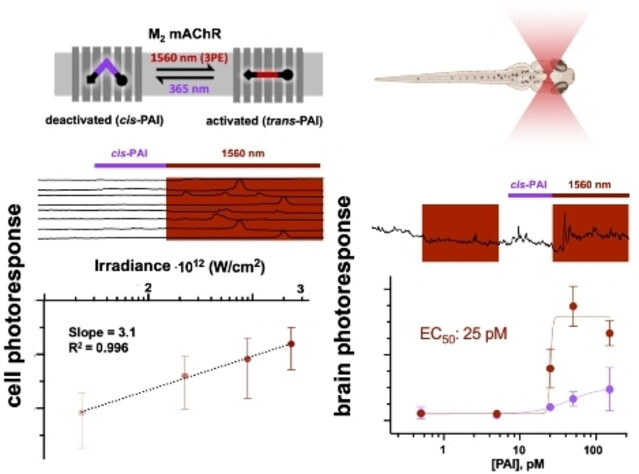
The photoswitchable muscarinic agonist PAI can regulate zebrafish brain activity at 25 pM with 1560 nm mid-infrared light. The cis isomer of PAI does not activate the M2 muscarinic acetylcholine receptor (mAChR) whereas the trans isomer is a full agonist. The third-power dependence of cis-to-trans isomerization and cellular activation with the irradiance demonstrates three-photon excitation and is relevant to all azobenzene-based photoswitches.
Artificial Metalloenzymes | Hot Paper
Anchoring a Structurally Editable Proximal Cofactor-like Module to Construct an Artificial Dual-center Peroxygenase
- First Published: 15 September 2023
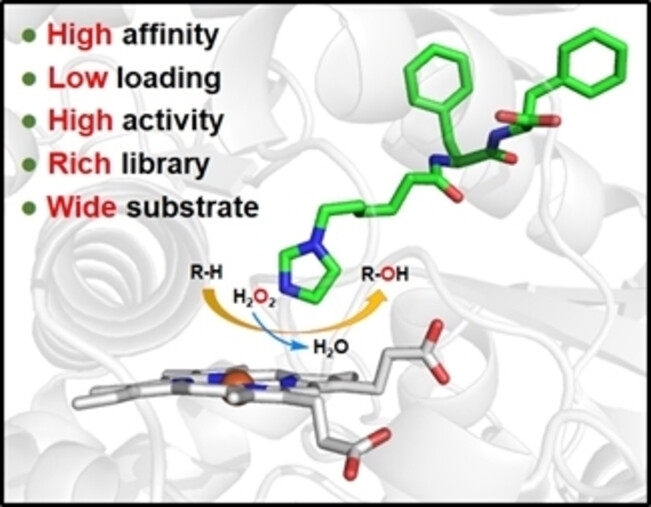
An editable organic cofactor was anchored to the proximal position of the heme center of P450BM3 as a co-catalytic center to construct an artificial dual-center peroxygenase. High binding affinity ensures a low load requirement for the efficient co-activation of H2O2, resulting in high peroxygenase activity. Structure editability enriches cofactor library diversity to widen the substrate range and increase the catalytic promiscuity of peroxygenase.
Drug Design
1-Azaspiro[3.3]heptane as a Bioisostere of Piperidine
- First Published: 11 October 2023
Activity-Based Protein Profiling
Chemical Proteomic Discovery of Isotype-Selective Covalent Inhibitors of the RNA Methyltransferase NSUN2
- First Published: 01 November 2023
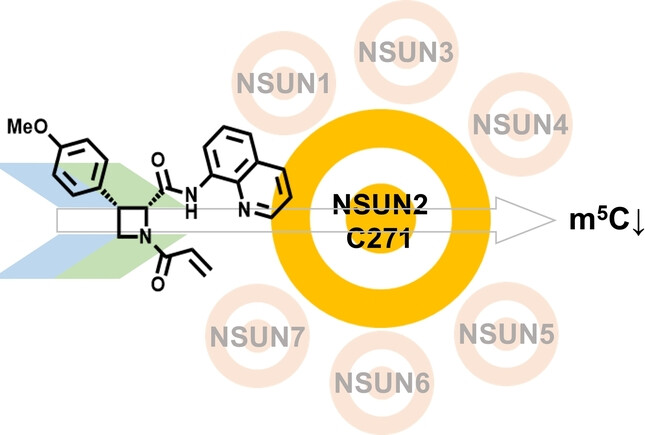
Activity-based protein profiling identifies azetidine acrylamides that covalently inhibit the RNA methyltransferase NSUN2 through targeting a conserved catalytic cysteine. The azetidine acrylamides show high isotype selectivity and perturb NSUN2-tRNA interactions and the 5-methylcytosine (m5C) content of RNA in cancer cells.
Biophysics
Isolation and Characterization of Monomeric Human RAD51: A Novel Tool for Investigating Homologous Recombination in Cancer
- First Published: 04 November 2023

We report the isolation of a fully human monomeric RAD51, a unique tool for cancer research. Biophysical assays—isothermal titration calorimetry (ITC), fluorescence polarization (FP), and nuclear magnetic resonance (NMR)—allowed evaluating the ability of the protein to retain the binding to BRC4. AlphaFold2 (AF2) modeling of small-angle X-ray scattering (SAXS) data revealed novel insights on the RAD51 behavior upon BRC4 binding.
Organocatalysis
Late-Stage Halogenation of Peptides, Drugs and (Hetero)aromatic Compounds with a Nucleophilic Hydrazide Catalyst
- First Published: 06 November 2023
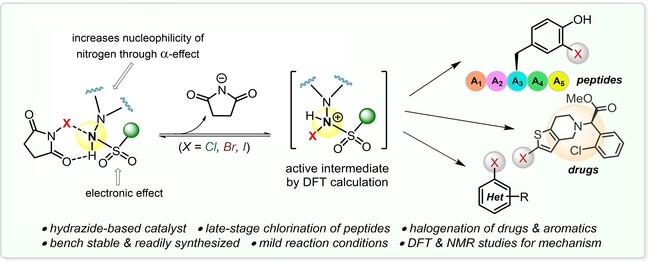
A hydrazide catalyst is introduced for the late-stage halogenation of peptides, drugs and (hetero)aromatics with high efficiency and selectivity. The active site comprises the hydrazide group attached to a sulfonamide moiety, which facilitates the acceptance as well as delivery of halonium species from the N-halosuccinimide source to the substrates, thus featuring a cooperative interaction.
Renewable Polymers
Neighboring Molecular Engineering in Diels–Alder Chemistry Enabling Easily Recyclable Carbon Fiber Reinforced Composites
- First Published: 27 September 2023

A strategy of tailoring dynamic covalent bonds with a low rotational energy barrier was proposed to fabricate phosphate-derived Diels–Alder crosslinked recyclable thermosets and their composites, simultaneously overcoming the trade-off between recycling efficiency and comprehensive properties in current covalent adaptable materials and offering a guidance for the rational design of sustainable thermosetting polymers for versatile applications.
Oxygen Reduction Reaction | Hot Paper
Cations Determine the Mechanism and Selectivity of Alkaline Oxygen Reduction Reaction on Pt(111)
- First Published: 20 November 2023
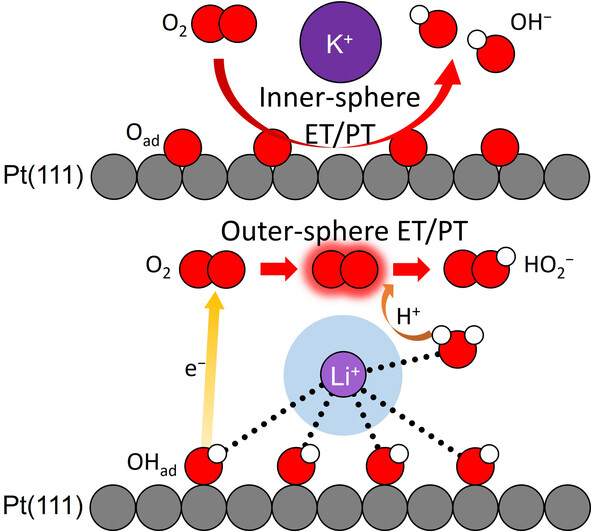
The electron/proton transfer (ET/PT) mechanism of the alkaline oxygen reduction reaction (ORR) on the Pt(111) electrode is dependent on electrolyte cations. In KOH, the 4e− inner-sphere (IS) ET/PT pathway proceeds on the surface, and adsorbed oxide species block the IS pathway. In LiOH, adsorbed OH and interfacial water stabilized by hydrated Li+ promote the 2e− outer-sphere (OS) ET/PT pathway in parallel with the IS pathway.
Zn-ion Batteries
Hybrid Superlattice-Triggered Selective Proton Grotthuss Intercalation in δ-MnO2 for High-Performance Zinc-Ion Battery
- First Published: 04 November 2023

Hybrid superlattice MnO2 is constructed by polyvinylpyrrolidone (PVP) pre-intercalation, where it achieves the synergy of electron entropy increase, selective H+ Grotthuss intercalation, inhibited transfer of hydrated [Zn(H2O)6]2+ ions, all contributing to the high capacity, accelerated rate capability and high cycle stability of Zn−MnO2 batteries.
Macrolide Natural Products | Very Important Paper
Total Synthesis of the Proposed Structure of Neaumycin B
- First Published: 27 October 2023
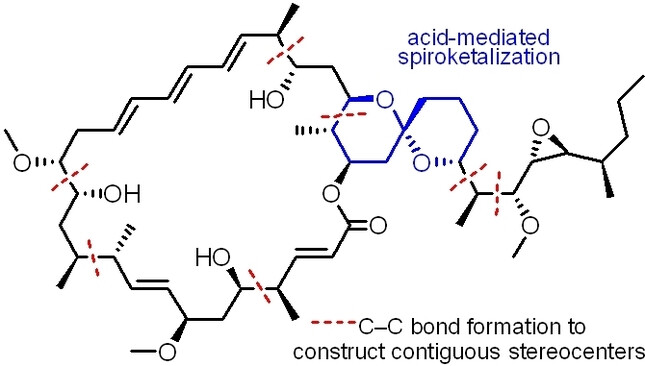
Total synthesis of the proposed structure of neaumycin B was achieved in 22 steps (longest linear sequence) through acid-mediated spiroketalization and a combination of efficient C−C bond forming reactions, including Krische iridium-catalyzed crotylation, Marshall palladium-catalyzed propargylation, Fürstner nickel-catalyzed regio- and enantioselective vicinal monoprotected diol formation, Brown crotylation and asymmetric halide-aldehyde cycloaddition.
Heterogeneous Catalysis
Electric Field Enhanced Ammoxidation of Aldehydes Using Supported Fe Clusters Under Ambient Oxygen Pressure
- First Published: 06 November 2023
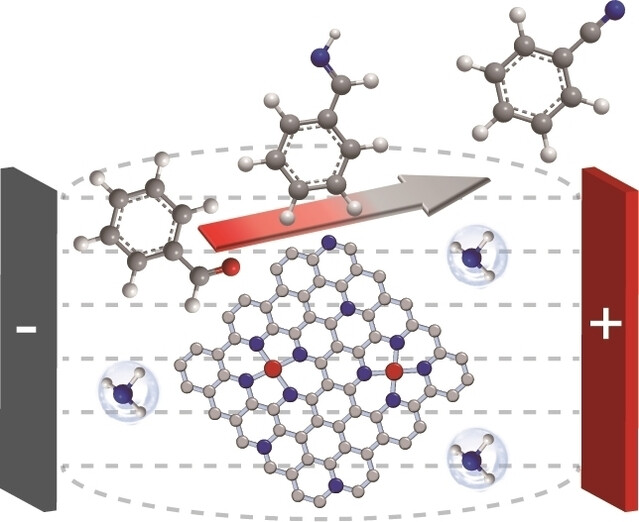
Ammoxidation of aldehydes under ambient oxygen pressure by external electric field and supported Fe clusters is reported. This ammoxidation system presents high efficiency for the conversion of a series of aldehydes under mild conditions, rendering it an attractive process for the synthesis of nitriles.
Solar Cells | Hot Paper
Efficient All-Perovskite Tandem Solar Cells with Low-Optical-Loss Carbazolyl Interconnecting Layers
- First Published: 03 November 2023
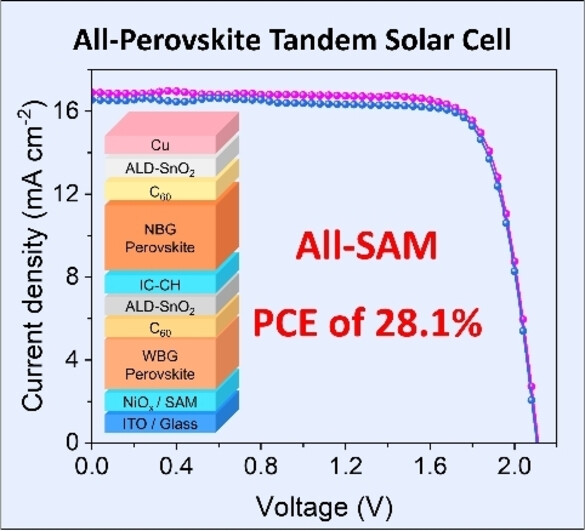
In this study, a high-quality hole transport layer, IC-CH, is developed by anchoring mixed carbazolyl hole-selective-molecules on optically transparent indium tin oxide nanocrystals films for mixed Pb-Sn NBG PSCs and all-perovskite tandem solar cells. The first evidence of all-perovskite tandem solar cells based on all-SAMs HTL (without PEDOT : PSS) is demonstrated, with efficiency as high as 28.1 %.
Covalent Organic Frameworks
Embedding Hydrogen Atom Transfer Moieties in Covalent Organic Frameworks for Efficient Photocatalytic C−H Functionalization
- First Published: 03 November 2023
High-Valent Metal Centers | Hot Paper
Uncovering a CF3 Effect on X-ray Absorption Energies of [Cu(CF3)4]− and Related Copper Compounds by Using Resonant Diffraction Anomalous Fine Structure (DAFS) Measurements
- First Published: 08 November 2023
![Uncovering a CF3 Effect on X-ray Absorption Energies of [Cu(CF3)4]− and Related Copper Compounds by Using Resonant Diffraction Anomalous Fine Structure (DAFS) Measurements**](/cms/asset/810d90e5-223b-4039-9709-6c0a8d455f47/ange202313744-toc-0001-m.jpg)
The electronic structures of [Cu(CF3)4]− and other Cu−CF3 complexes are (re−)evaluated using resonant X-ray diffraction methods. A systematic trend was identified by which each additional CF3 ligand shifts the resonant Cu K-edge energy by 2–3 eV, completely accounting for observed differences between complexes with different formal oxidation states. The recently debated assignment of [Cu(CF3)4]− as containing a Cu(I) ion is, thus, verified.
Electrocatalysis
Understanding the Synergy between Fe and Mo Sites in the Nitrate Reduction Reaction on a Bio-Inspired Bimetallic MXene Electrocatalyst
- First Published: 31 October 2023

Inspired by the active sites of the nitrate reductase enzymes, Fe-substituted two-dimensional molybdenum carbide, Mo2CTx : Fe, is studied here and found to display unique performances in the electrochemical reduction of nitrate to ammonia, outperforming its monometallic counterpart Mo2CTx. In situ XAS and DFT calculations reveal that this difference in reactivity results from the vacancy-formation-promoting effect of Fe sites in Mo2CTx : Fe.
Gas Separation | Very Important Paper
Spatial Distribution of Nitrogen Binding Sites in Metal-Organic Frameworks for Selective Ethane Adsorption and One-Step Ethylene Purification
- First Published: 07 November 2023

The metal-Organic framework MOF-808-Bzz, which incorporates benzimidazole into MOF-808, features two dispersed nitrogen atoms. It demonstrates remarkable performance in the one-step purification of ethylene from ternary mixtures. The strategically positioned active sites create an optimal geometry, facilitating the efficient entrapment of ethane molecules through the formation of multiple robust C−H⋅⋅⋅N hydrogen bonds and C−H⋅⋅⋅π interactions.
Homogeneous Catalysis | Hot Paper
Phenoxythiazoline (FTz)-Cobalt(II) Precatalysts Enable C(sp2)–C(sp3) Bond-Formation for Key Intermediates in the Synthesis of Toll-like Receptor 7/8 Antagonists
- First Published: 02 November 2023
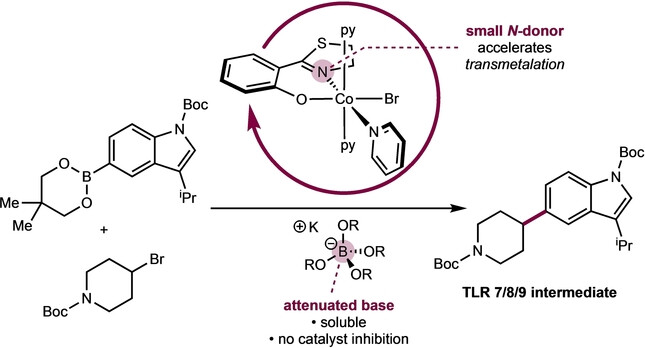
Supporting ligand effects in cobalt-catalyzed C(sp2)–C(sp3) Suzuki–Miyaura cross coupling demonstrated accelerated rates of reaction with smaller imine substituents. This effect arises from increased rates of turnover limiting transmetallation and was translated onto a high yielding method for the synthesis of a key intermediate in a TLR7/8 antagonist. Studies into the cobalt coordination chemistry enabled use of air-stable precatalysts.
Polyoxometalates
Self-Assembly of Polyoxometalate-Based Sub-1 nm Polyhedral Building Blocks into Rhombic Dodecahedral Superstructures
- First Published: 02 November 2023

Tailoring the spatial distribution of ligands on polyoxometalates has led to subnanometer rhombic dodecahedral building blocks being obtained. The anisotropy of these sub-1 nm building blocks results in them self-assembling into rhombic dodecahedral assemblies, which exhibit excellent catalytic performance in the cycloaddition of CO2 with epoxides.
Organic Chemistry
Experimental and Theoretical Study of Phosphine-Catalyzed Reaction Modes in the Reaction of α-Substituted Allenes with Aryl Imines
- First Published: 31 October 2023

A phosphine-catalyzed reaction of α-substituted allenes with aryl imines delivers valuable highly functionalized itaconimide derivatives with excellent stereoselectivities: The reaction was found to exhibit an unusual reaction mode involving the β′-carbon position of α-substituted allenes under mild conditions. Mechanistic studies and control experiments reveal the crucial role of H2CO3 for the present reaction mode.
Photocatalysis | Hot Paper
Triangle Cl−Ag1−Cl Sites for Superior Photocatalytic Molecular Oxygen Activation and NO Oxidation of BiOCl
- First Published: 24 October 2023
Asymmetric Catalysis
Nitrene-Mediated Enantioselective Intramolecular Olefin Oxyamination to Access Chiral γ-Aminomethyl-γ-Lactones
- First Published: 06 November 2023

Nitrene-mediated asymmetric intramolecular olefin difunctionalization is introduced, in which the nitrene intermediate adds in an unprecedented exocyclic fashion and the nucleophile in an endocyclic fashion. This atom-economic strategy affords chiral γ-aminomethyl-γ-lactones in high yields and excellent enantioselectivities and provides access to versatile chiral building blocks.
Solid-State Batteries
On the Origin of the Non-Arrhenius Na-ion Conductivity in Na3OBr
- First Published: 30 October 2023
Aqueous Zn Batteries
Guiding Zn Uniform Deposition with Polymer Additives for Long-lasting and Highly Utilized Zn Metal Anodes
- First Published: 06 November 2023
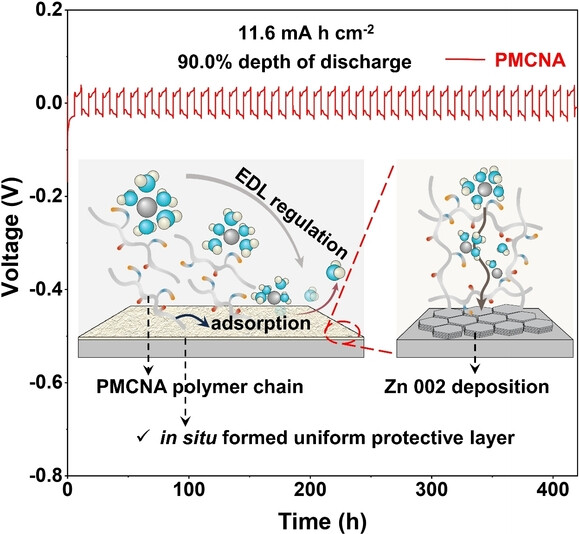
Regulating the interactions between zwitterionic polymer additive and Zn anode can construct an in situ formed uniform protective layer on Zn metal to resist side reactions and guide the Zn even deposition and nucleation along 002 plane, thus rendering the symmetrical Zn//Zn battery and Zn full devices with great performance at high Zn utilization.
Dual-ion Batteries | Hot Paper
Significant Strain Dissipation via Stiff-Tough Solid Electrolyte Interphase Design for Highly Stable Alloying Anodes
- First Published: 26 October 2023
Hybrid Bronzes | Very Important Paper
Controlling Electron Delocalization in Vanadium-Based Hybrid Bronzes through Molecular Templation
- First Published: 02 November 2023
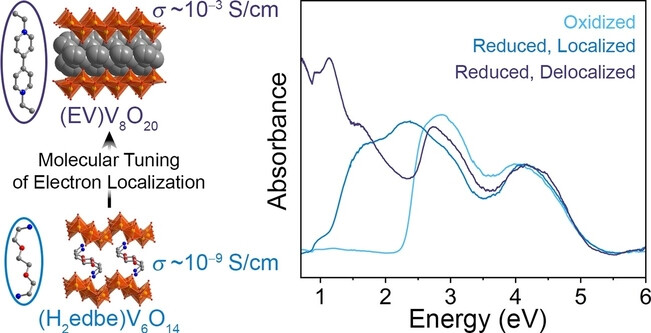
Hybrid vanadium bronzes are air-stable mixed-valence organic–inorganic metal oxides that can be synthesized under mild aqueous conditions and that show versatile optical and electronic properties. The degree of electron delocalization in this material platform can be controlled through molecular templation principles, allowing electronic conductivity to be tuned over six orders of magnitude.
Peptides
Side-Chain Chemistry Governs Hierarchical Order of Charge-Complementary β-sheet Peptide Coassemblies
- First Published: 06 November 2023

Co-assembly of charge-complementary peptides affords opportunities to create fibrillar biomaterials with molecular-level features that cannot be achieved in single-component systems. However, our ability to predict fibrillar network architecture based on peptide pair sequence characteristics is lacking. This report shows how the type of charged amino acid affects supramolecular organization in charge-complementary β-sheet peptide co-assemblies.
Polymer Recycling
Bicyclic Guanidine Promoted Mechanistically Divergent Depolymerization and Recycling of a Biobased Polycarbonate
- First Published: 07 November 2023
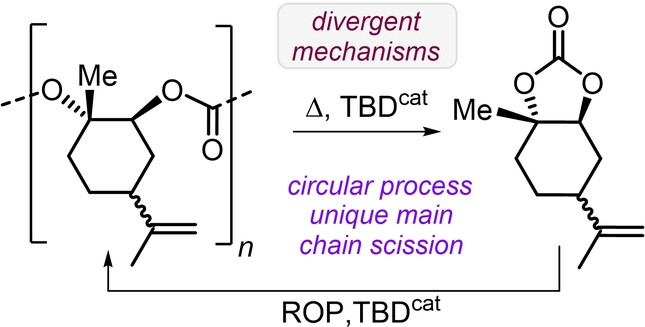
Organocatalytic depolymerization of poly(limonene carbonate) and related macromolecules is reported. The main degradation product, limonene carbonate, can be repolymerized via ring-opening polymerization using the same organocatalyst providing a potential circular process. The mechanistic intricacies of this polymer depolymerization have been scrutinized in detail revealing the concomitant occurrence of complementary and unique degradation modes.
N-Heterocyclic Carbenes
Uncovering Nitrosyl Reactivity at N-Heterocyclic Carbene Center
- First Published: 02 November 2023

N-heterocyclic carbene (NHC) nitrosyl derivatives were prepared from redox chemistries of NHC nitric oxide radical ([NHC−NO]⋅). Under electrochemical conditions, [NHC−NO]⋅ underwent reversible one-electron oxidation to [NHC−NO]+ while the reduction led to [NHC−NO]− and was found irreversible. These reactivities were further studied and found to resemble those of transition metal nitrosyl complexes while differing from oxime radicals.
Mass Spectrometry
Distinguishing Protein Chemical Topologies Using Supercharging Ion Mobility Spectrometry-Mass Spectrometry
- First Published: 08 November 2023

The topological features of complex proteins, previously concealed by their inherent complexity, can now be easily classified through the application of supercharging electrospray ionization coupled with ion mobility spectrometry-mass spectrometry. By overcharging the protein backbones, limitations in protein elongation depending on the protein topology become evident, thereby establishing a visual standard for discerning protein topologies.
Molecular Carbons
Diradicaloid Boron-Doped Molecular Carbons Achieved by Pentagon-Fusion
- First Published: 04 November 2023
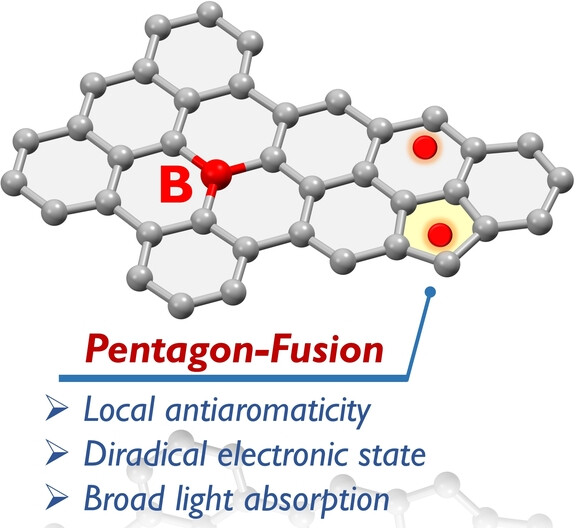
Pentagon-fusion of an organoborane π-system has led to the generation of open-shell boron-doped molecular carbons (BMCs). Theoretical and experimental studies demonstrate that the two as-synthesized BMCs containing a pentagonal ring have local antiaromaticity, an internal quinoidal substructure and thus singlet diradical structures, as well as intriguing properties, such as very broad light absorption and superior photothermal capability.
Polymer Recycling | Hot Paper
Thermally Robust yet Deconstructable and Chemically Recyclable High-Density Polyethylene (HDPE)-Like Materials Based on Si−O Bonds
- First Published: 30 October 2023
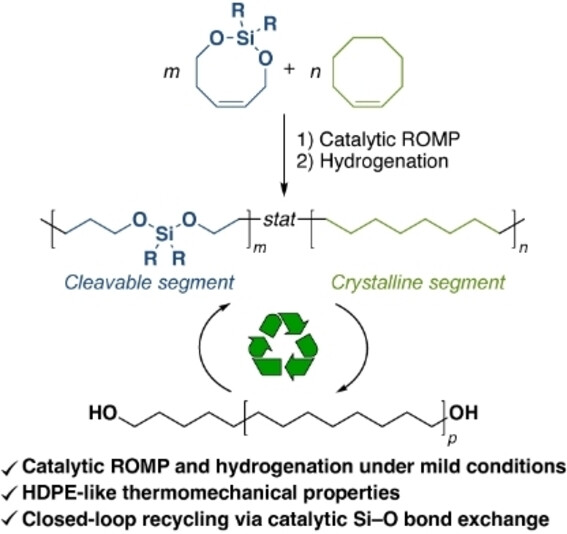
Bifunctional silyl ether (BSE)-containing high-density polyethylene (HDPE)-like materials have been synthesized under mild polymerization and hydrogenation conditions. Both the concentration of BSEs in the polymer chain and the silicon steric bulk can be tuned to yield materials with HDPE-like thermomechanical properties. The materials undergo two distinct deconstruction pathways and can be recycled without compromising their mechanical strength.
Zinc-Ion Batteries | Very Important Paper
Engineering Fluorine-rich Double Protective Layer on Zn Anode for Highly Reversible Aqueous Zinc-ion Batteries
- First Published: 04 November 2023
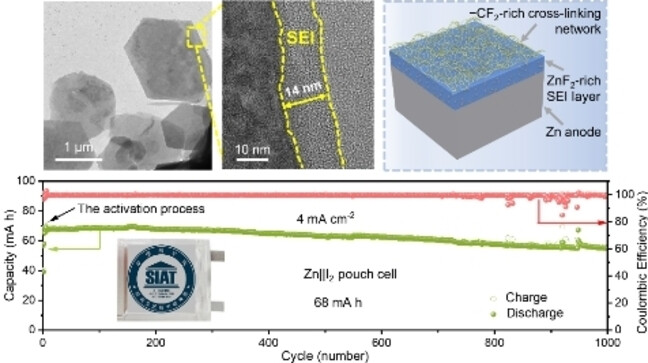
A fluorine-rich double protective layer on the Zn anode is in situ built by the cross-linking and decomposition of tetradecafluorononane-1,9-diol (TDFND) electrolyte additive, which can not only balance space electric field and control the Zn2+ ion flux to achieve the compact deposition of Zn (002) crystal planes but also block the direct contact of active water and the Zn anode to suppress side reactions, leading to high-performance AZIBs.
Gene Editing
A DNA Origami-Based Gene Editing System for Efficient Gene Therapy in Vivo
- First Published: 31 October 2023

DNA nanostructures have been widely developed as the smart drug delivery systems. Herein, a DNA origami with precisely organized PAM-rich region on its surface has been constructed to efficiently recruit and load sgRNA/Cas9 complex by PAM-guided assembly and pre-designed DNA/RNA hybridization for targeted gene editing of tumor-associated gene. This DNA origami-based gene editing system has achieved a pronounced gene therapy in vivo.
Analytical Methods | Hot Paper
A Magnetically Driven Tandem Chip Enables Rapid Isolation and Multiplexed Profiling of Extracellular Vesicles
- First Published: 08 November 2023
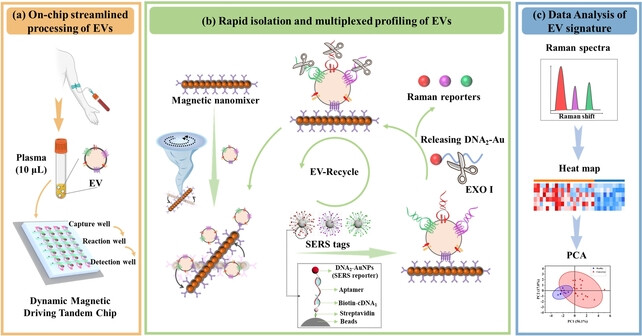
A magnetically driven tandem chip integrated with magnetic nanomixers and cyclic SERS tags was developed to achieve streamlined rapid isolation and multiplexed profiling of EVs. Six protein markers were analysed simultaneously using only 10 μL plasma within 1.5 h. The EV signature offers precise diagnosis of breast cancer patients.
COF Films | Hot Paper
Adjustable Plane Curvature of Covalent Organic Framework Enabling Outstanding Dielectric, Electret, and High-Temperature Processing Properties
- First Published: 14 November 2023
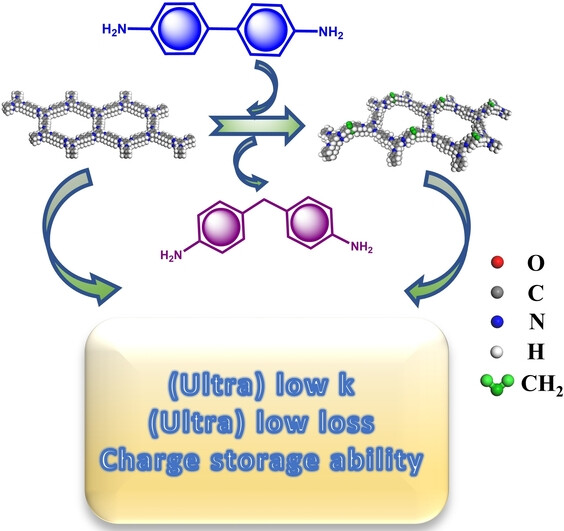
In this manuscript, the microstructure, dielectric, and electret properties of the covalent organic framework films are modulated by adjusting the ratio of 4,4-diamino biphenyl and 4,4-diaminodiphenylmethane. The resulting films present excellent dielectric properties (ultralow dielectric constant (1.9), ultralow dielectric loss (0.0052) at 200 °C) and are very promising for use in electronic devices serving in high-temperature environments.
Ferroelectric Compounds
A Homochiral Fulgide Organic Ferroelectric Crystal with Photoinduced Molecular Orbital Breaking
- First Published: 02 November 2023
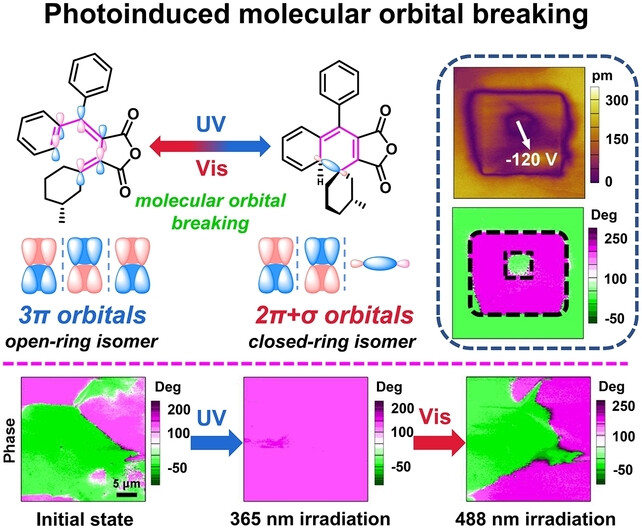
A homochiral organic fulgide ferroelectric crystal was synthesized that showed a photoinduced reversible change in its molecular orbitals between its open-ring and closed-ring isomers. This behavior is significantly distinct from the thermally triggered spatial symmetry breaking in traditional ferroelectrics and enables reversible switching of ferroelectric domains by optical manipulation.
Zn-ion Batteries
Pre-intercalation of Ammonium Ions in Layered δ-MnO2 Nanosheets for High-Performance Aqueous Zinc-Ion Batteries
- First Published: 06 November 2023

δ-MnO2 nanosheets with intercalated ammonium ions (AMO) are synthesized via a self-templated strategy as a Zn-ion battery cathode. The incorporation of ammonium ions enlarges the interlayer space and forms hydrogen bonds for enhanced structural robustness and fast reaction kinetics. As a result, the AMO cathode exhibits exceptional rate performance and long lifespan in full cells.
Biosensing
A Colorimetric Biosensing Platform with Aptamers, Rolling Circle Amplification and Urease-Mediated Litmus Test
- First Published: 30 October 2023
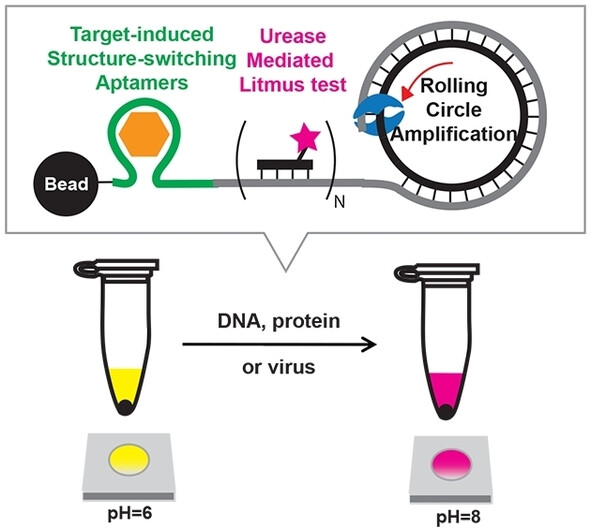
Sensitive and simple-to-use colorimetric sensors are highly desirable for point-of-care diagnostic applications. Here we report on an ultra-sensitive colorimetric sensing platform that takes advantage of both the strong amplification power of rolling circle amplification and the high efficiency of a urease-mediated litmus test. By using aptamers for target recognition, this platform can be adapted for a wide range of sensing applications.
Coordination Cages
Diastereoselective Self-Assembly of Low-Symmetry PdnL2n Nanocages through Coordination-Sphere Engineering
- First Published: 27 October 2023
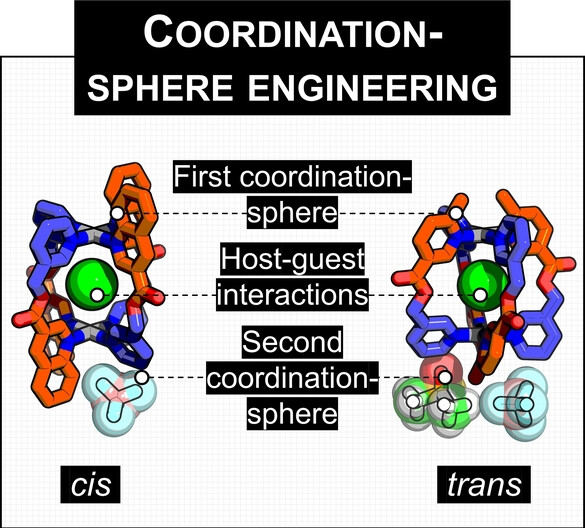
Often overlooked second coordination sphere effects are shown to be of significant importance in isomer selectivity with self-assembled, low-symmetry metal-organic cages. In some instances, these effects override primary structural factors that are often the only consideration when designing such systems.
Iron Catalysis | Hot Paper
Iron-Catalyzed Stereoconvergent 1,4-Hydrosilylation of Conjugated Dienes
- First Published: 07 November 2023
DNA Nanotechnology
Impact of the Core Chemistry of Self-Assembled Spherical Nucleic Acids on their In Vitro Fate
- First Published: 31 October 2023

In physiological conditions, self-assembled spherical nucleic acids made from DNA amphiphiles encounter abundant serum proteins. Because they are held through weak non-covalent interactions, they might disassemble, impacting their biological activity. Here, we investigate the biological fate of SNAs and the impact of core chemistry and stimuli-responsive crosslinking on their stability, providing guidelines for the biological applications of these self-assembled structures.
Macrocycles
A Chiral Emissive Conjugated Corral for High-Affinity and Highly Enantioselective Recognition in Water
- First Published: 02 November 2023
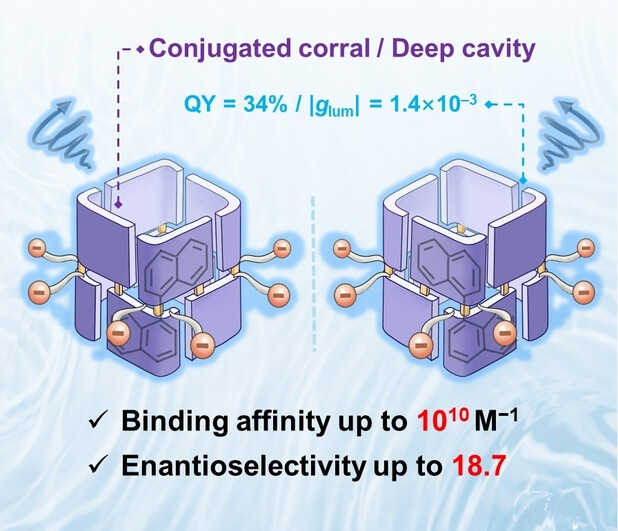
A pair of water-soluble enantiomeric macrocycles was prepared using a chiral 1,1′-bi-2-naphthol derivative as the building unit. The conjugated backbone results in the macrocycles having attractive chiral emissive properties, exceptional recognition affinity (up to 1010 M−1) and excellent enantioselectivity (up to 18.7) in water.
Biosensors | Very Important Paper
Complete Glucose Electrooxidation Enabled by Coordinatively Unsaturated Copper Sites in Metal–Organic Frameworks
- First Published: 08 November 2023
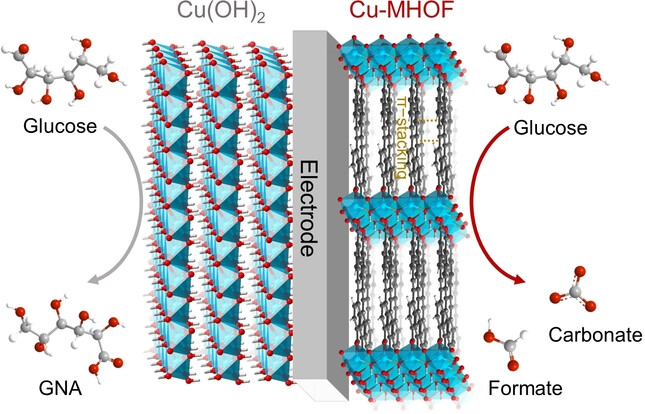
The electrocatalytic oxidation of glucose typically occurs via a 2-electron process, hampering practical applications. This study introduces a novel Cu-based metal-hydroxide organic framework, enabling complete glucose oxidation to formate and carbonate, potentially releasing 24 electrons per glucose molecule. It holds substantial promise for sensors, energy conversion and biomass upscaling.
Zuschriften
C-H Activation
Iron-Catalyzed Intermolecular C−H Amination Assisted by an Isolated Iron-Imido Radical Intermediate
- First Published: 10 October 2023
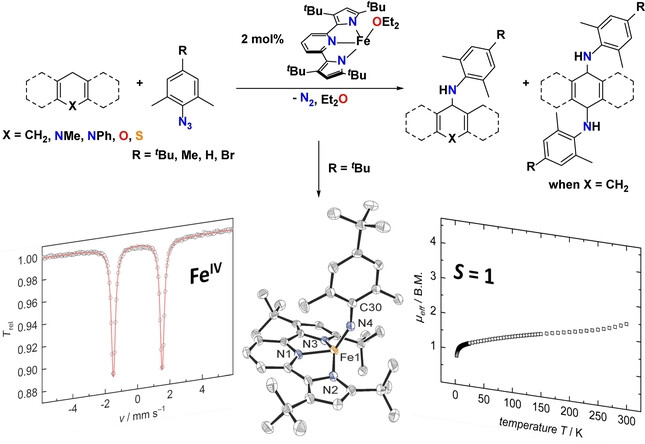
A mononuclear imido radical species [(tBupyrpyrr2)Fe{=N(2,6-Me2-4-tBu-C6H2)](1-imido) was isolated and confirmed to be an S=1 Fe(IV) complex. Complex 1-imido [(tBupyrpyrr2)Fe(OEt2)](1-OEt2), its precursor, or the C-H inserted secondary amine adduct [(tBupyrpyrr2)Fe{NH(2,6-Me2-4-tBu-C6H2)(C14H11)}](1-aniline), were all shown to be catalysts for intermolecular amination of Csp3-H bonds using 2,6-trimethyl-substituted Ph-azides as nitrene source.
Analytical Methods
Bioactive Luminescent Silver Clusters Confined in Zeolites Enable Quick and Wash-Free Biosensing
- First Published: 02 October 2023

Antibody-functionalized zeolites embedding photoluminescent silver clusters offer simultaneous capture and detection of biomolecules since immunocomplex formation triggers fluorometric enhancement in the explored biohybrid. This simple biosensing concept will open the way to innovative miniaturized and portable bioanalytical platforms.
Polycycles
Synthesis of Heptagon-Containing Polyarenes by Catalytic C−H Activation
- First Published: 30 October 2023
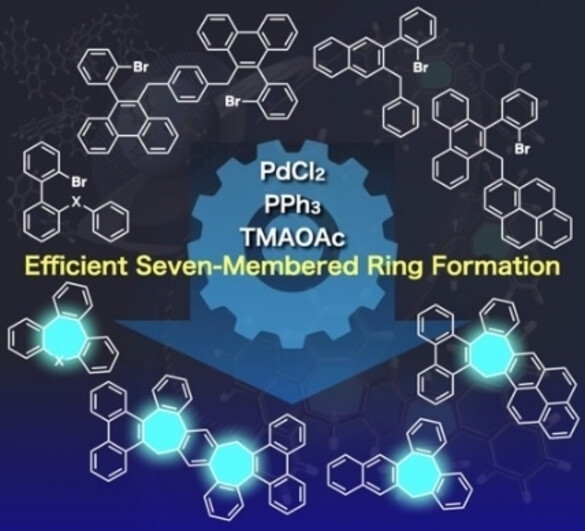
Herein, we report an efficient synthetic method, involving a Pd-catalyzed intramolecular coupling, for polycyclic aromatic compounds containing seven-membered rings. A variety of heptagon-containing molecular nanocarbons were synthesized. In addition, a one-pot synthetic method comprising Rh-catalyzed annulation and Pd-catalyzed cyclization was developed. Furthermore, it was possible to construct two seven-membered rings simultaneously.
Photochemistry | Hot Paper
Visible Light Induced Copper-Catalyzed Enantioselective Deaminative Arylation of Amino Acid Derivatives Assisted by Phenol
- First Published: 07 November 2023

A visible light induced enantioselective deaminative arylation of amino acid derivatives by bifunctional copper catalysis is disclosed. A variety of α-aryl-N-phenylamides are prepared with good efficiency and high enantioselectivity. A possible reaction mechanism and an asymmetric induction mode have been proposed based on experimental and computational evidence.
Electrocatalysis
Adapting Synthetic Models of Heme/Cu Sites to Energy-Efficient Electrocatalytic Oxygen Reduction Reaction
- First Published: 03 November 2023
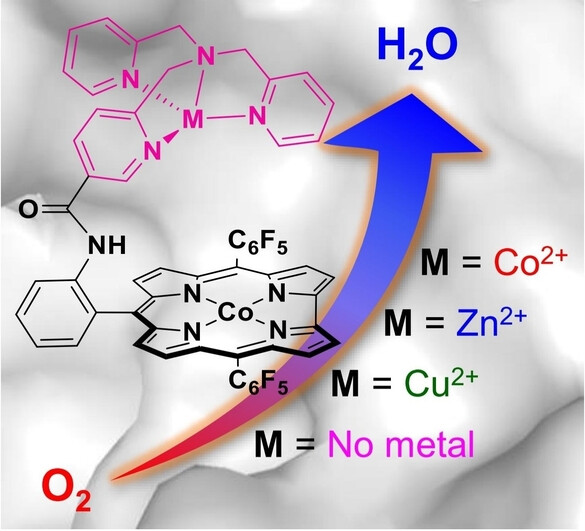
A synthetic Co-corrole/Co complex is synthesized by hanging a CoII ion over a Co corrole unit. This bioinspired complex realizes the four-electron electrocatalytic O2 reduction with a half-wave potential of 0.89 V versus RHE, which represents an outstanding activity for molecular electrocatalysts. By mimicking the function of the CuI ion in biological heme/Cu sites, the hanging CoII ion provides an electron to improve O2 binding and activation.
Solar Cells | Hot Paper
Surface Termination on Unstable Methylammonium-based Perovskite Using a Steric Barrier for Improved Perovskite Solar Cells
- First Published: 30 October 2023
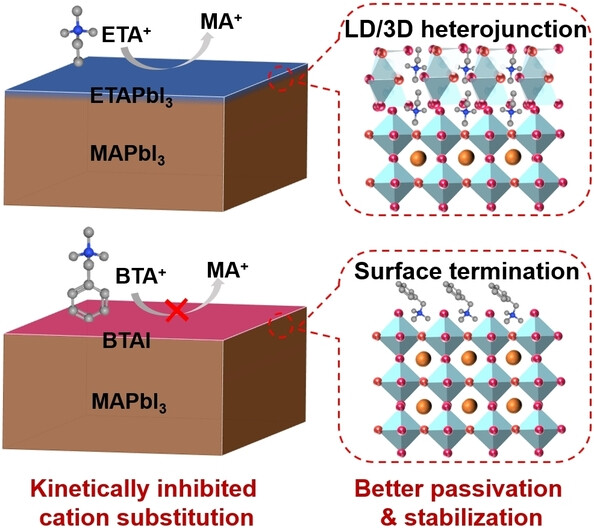
Surface termination can passivate perovskite films and avoid the degradation of low-dimensional/three-dimensional (LD/3D) heterojunctions, but it's difficult to realize surface termination to hybrid perovskites due to the fast cation exchange. Here, a benzyltrimethylammonium cation with rational designed steric barrier can effectively surface terminate methylammonium lead iodide (MAPbI3) with a wide processing window and enhanced stability.
Biocatalysis | Hot Paper
Non-native Intramolecular Radical Cyclization Catalyzed by a B12-Dependent Enzyme
- First Published: 24 October 2023

A B12-dependent enzyme, CarH*, was engineered that can efficiently catalyze the radical cyclization of halide substrates containing a pendant olefin or alkyne, enabling the synthesis of a series of α,α-difluorinated lactams. Additionally, CarH* displayed an intriguing ability to mediate reductive dearomative spirocyclization of substrates with aromatic acceptors to generate spirobicycles, featuring uncommon 1,3-cyclohexadiene selectivity.
Asymmetric Synthesis
Enantioselective Synthesis of Bicyclo[3.2.1]octadienes via Palladium-Catalyzed Intramolecular Alkene-Alkyne Coupling Reaction
- First Published: 03 November 2023
![Enantioselective Synthesis of Bicyclo[3.2.1]octadienes via Palladium-Catalyzed Intramolecular Alkene-Alkyne Coupling Reaction](/cms/asset/db20e922-d973-411d-9c7d-b71811ed5aaf/ange202313404-toc-0001-m.jpg)
An unprecedent palladium-catalyzed asymmetric intramolecular alkene-alkyne coupling of alkyne-tethered cyclopentenes has been realized. A variety of chiral bicyclo[3.2.1]octadienes were prepared in good yields with excellent enantioselectivities. Moreover, the products could undergo an uncommon iodination-induced 1,2-acyl migration, providing iodinated bicyclo[3.2.1]octadienes with three vicinal stereocenters.
Analytical Methods | Very Important Paper
Fast Antioxidation Kinetics of Glutathione Intracellularly Monitored by a Dual-Wire Nanosensor
- First Published: 01 November 2023
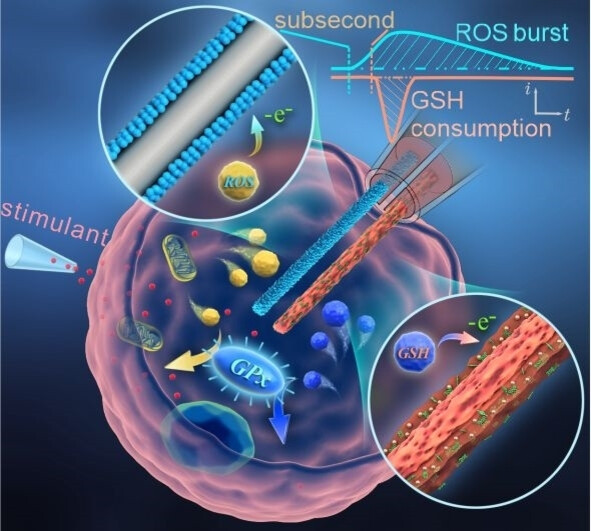
The rapid kinetics between the glutathione (GSH) system and reactive oxygen species (ROS) remain unclear. We developed a dual-wire nanosensor that can selectively and synchronously measure intracellular GSH and ROS with a high temporal resolution, and applied it to study resveratrol (RSV)-treated cancer cells. The GSH system is rapidly triggered by the ROS burst in a sub-second time scale and works only for a few seconds with some residual ROS.
Heterocycles
Copper-Catalyzed Oxygenative Skeletal Rearrangement of Tetrahydro-β-carbolines Using H2O and O2 as Oxygen Sources
- First Published: 10 November 2023
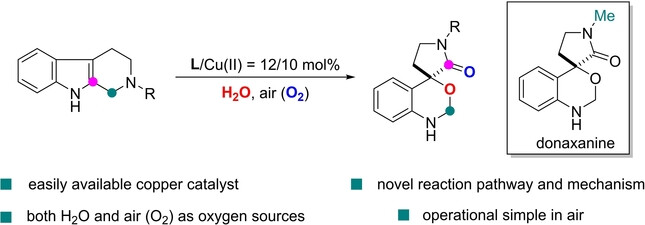
An unprecedented oxygenative skeletal rearrangement reaction of tetrahydro-β-carbolines (THβCs) was developed under mild conditions enabled by copper-catalyzed single-electron transfer oxidation, in which H2O and O2 act as oxygen sources to generate a unique 2-hydroxyl-3-peroxide indoline intermediate. The process involves a multistep sequence to enable the transformation of THβCs to donaxanine-type heterocycles in an efficient manner.
Solar Cells
Directional Defect Management in Perovskites by In Situ Decomposition of Organic Metal Chalcogenides for Efficient Solar Cells
- First Published: 08 November 2023
Dynamic Covalent Chemistry | Hot Paper
Dynamic Phosphorus: Thiolate Exchange Cascades with Higher Phosphorothioates
- First Published: 17 October 2023

Inspired by cell-penetrating disulfides and oligonucleotide phosphorothioates, dynamic covalent cascade exchange chemistry centered on phosphorus has been achieved using neutral higher phosphorotri- and -tetrathioates. They walk along Hammett gradients of thiolate exchangers in triton X-100 micelles, exchange with cysteine and glutathione in neutral water, and protect from thiol-mediated uptake into living cells.
C-H Functionalization
A Three-Component Arene Difunctionalization: Merger of C(sp3)/(sp2)−H Bond Addition
- First Published: 19 October 2023

A tandem three-component C−H bond addition involving the activation of an inert C(sp3)−H bond has been developed. The process enables the direct regioselective synthesis of 1,2-difunctionalized arenes with the formation of C(sp3)− and C(sp2)−C(arene) bonds from readily available precursors. The sulfoximine plays a key role in this double functionalization of 2-iodo benzoic acids as masked bifunctional reagents.
DNA Origami | Hot Paper
Light-Activated Assembly of DNA Origami into Dissipative Fibrils
- First Published: 30 October 2023
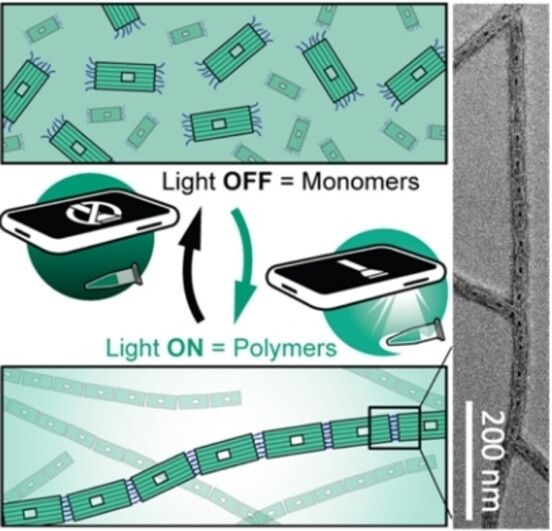
We build hierarchical DNA origami fibrils using protonated DNA strands. By employing a small molecule that releases protons during irradiation, our system is activated by light and is assembled under dissipative conditions. Generating no waste, our fibrils can be built and demolished multiple times, underscoring the utility of pH-responsive, non-canonical DNA motifs for out-of-equilibrium assembly.
Triple Helicates
In Situ Photoisomerization of an Azobenzene-Based Triple Helicate with a Prolonged Thermal Relaxation Time
- First Published: 05 November 2023

A model phosphate-coordination-driven triple helicate has been shown to undergo a unique in situ photoisomerization process. The triple helicates displayed an up to 20-fold suppression of the Z→E thermal relaxation rate compared to the free ligands. The chirality of the helicate can be regulated by encapsulating a chiral cationic guest inside the cavity of the Z-helicate, thus demonstrating a new light-activated chiroptical switch.
Cycloaddition Reactions
Synthesis of 2-Azanorbornanes via Strain-Release Formal Cycloadditions Initiated by Energy Transfer
- First Published: 14 November 2023
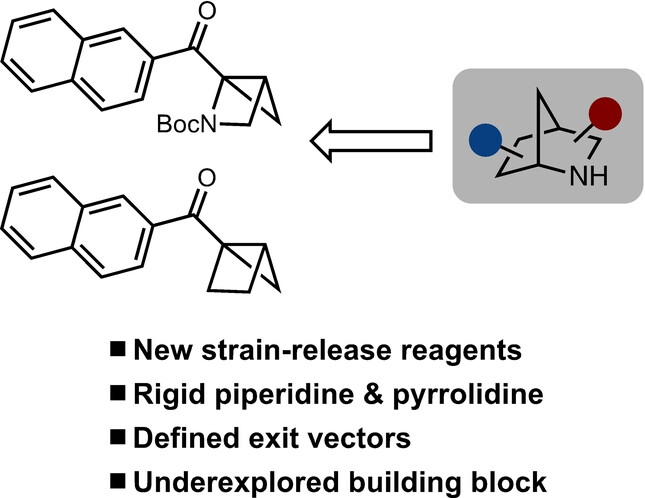
A strategy to prepare 2-azanorbornanes by photochemical strain-release formal cycloadditions is presented. The method involves the combination of azahousanes or housanes with alkenes or imines, respectively. The 2-azanorbornanes have defined exit vectors and represent new building blocks to enable drug development. The synthetic utility of the products is also demonstrated.
Metalloproteins | Very Important Paper
Maturation of the [FeFe]-Hydrogenase: Direct Transfer of the (κ3-cysteinate)FeII(CN)(CO)2 Complex B from HydG to HydE
- First Published: 14 November 2023
![Maturation of the [FeFe]-Hydrogenase: Direct Transfer of the (κ3-cysteinate)FeII(CN)(CO)2 Complex B from HydG to HydE](/cms/asset/15cb112f-dcc3-407e-ae78-f96155bfdd51/ange202314819-toc-0001-m.jpg)
The radical SAM protein HydG uses L-tyrosine, L-cysteine and ferrous ion to produce complex B, which corresponds to a (κ3-cysteinate)Fe(CN)(CO)2, organometallic compound. Complex B is subsequently transferred through direct contacts to the radical SAM protein HydE for further processing en route to the [FeFe]-hydrogenase H-cluster.
Synthetic Methods
A Sulfur Monoxide Surrogate Designed for the Synthesis of Sulfoxides and Sulfinamides
- First Published: 08 November 2023

A sulfinylhydrazine reagent for the synthesis of organosulfur(IV) functional groups is reported. The reagent is readily prepared from commercial starting materials and is amenable to thermal −S(O)− transfer to dienes. One-pot, three-component synthesis of sulfoxides and sulfinamides is further demonstrated by exploiting this reagent as an -S(O)- donor.
Asymmetric Synthesis
Asymmetric (4+1) Annulations by Cascade Allylation and Transient σ-Alkyl-Pd(II) Initiated Allylic Csp3−H Activation
- First Published: 03 November 2023

A unique catalytic approach for asymmetric (4+1) annulations via cascade allylation and transient σ-alkyl-Pd(II) initiated methylene Csp3−H activation is reported. Comparing to the well-established annulations via Heck-type C−H activations, this protocol showcases a conceptually new way to generate σ-alkyl-Pd(II) species which could initiate challenging asymmetric Csp3−H activations.
Macrocycles
Palladium-Catalyzed Enantioselective C−H Olefination to Access Planar-Chiral Cyclophanes by Dynamic Kinetic Resolution
- First Published: 02 November 2023

The first Pd(II)-catalyzed enantioselective C−H olefination of prochiral cyclophanes has been disclosed. The low rotational barrier of less hindered benzene ring in the substrates allows the reaction to proceed through a dynamic kinetic resolution. The chirality of the resulted cyclophanes arises from the bond rotation constraint of the benzene ring around the macrocycle plane, rather than the C−N axis.
Thermal Conductivity | Very Important Paper
Cu3BiS3: Two-Dimensional Coordination Induces Out-of-Plane Phonon Scattering Enabling Ultralow Thermal Conductivity
- First Published: 06 November 2023
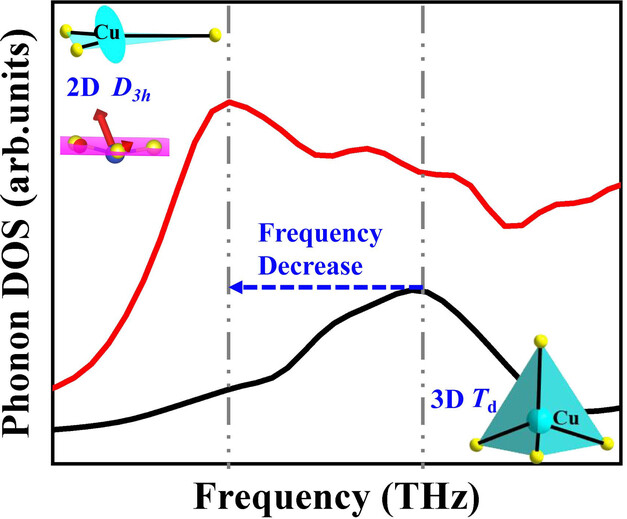
We report herein a groundbreaking discovery, thus highlighting the significant role of low-dimensional local coordination ([CuS3] D3h triangle plane) in lowering the thermal conductivity through characteristic out-of-plane phonon scattering, while also contributing to a large Grüneisen parameter. This allows Cu3BiS3 to exhibit one of the lowest κlat values (0.32 W/m K) reported so far.
Supramolecular Chemistry
Exploitation of Catalytic Dyads by Short Peptide-Based Nanotubes for Enantioselective Covalent Catalysis
- First Published: 03 November 2023
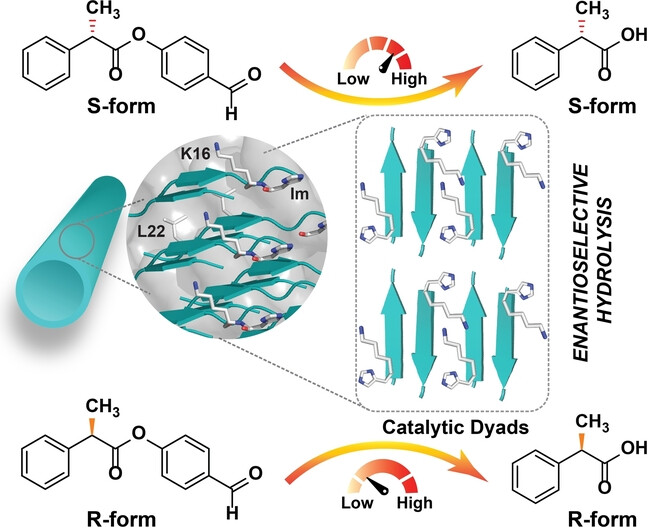
Short peptide-based amyloid nanotubes were able to demonstrate enantioselective covalent catalysis by exploiting chiral binding pockets with multiple solvent exposed residues. To achieve this, lysine was used for reversible imine formation, leucine for hydrophobic binding surface, and imidazole for the hydrolytic cleavage of the substrates.




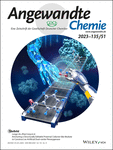


![1-Azaspiro[3.3]heptane as a Bioisostere of Piperidine**](/cms/asset/d773fc8a-0b98-40b0-a9b6-4282a2afa102/ange202311583-toc-0001-m.jpg)


